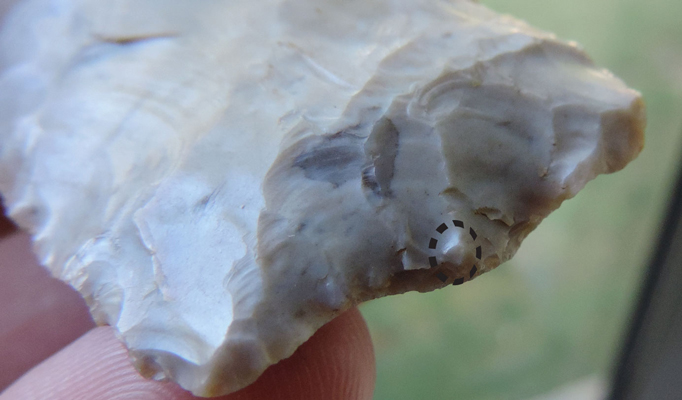Rare Clovis Point Preform Reveals New Insights
A Clovis fluted projectile point preform uncovered on a farm offers interesting new clues about how Clovis Paleo-Indians colonized prehistoric Northwest Ohio.
The 8.9 cm, approximately 13,000-year-old preform was rigorously analyzed by a team of researchers led by Dr. Metin Eren, Associate Professor and Director of Archaeology, Department of Anthropology at Kent State University and Research Associate at the Cleveland Museum of Natural History.
Other researchers included Dr. Brian Redmond, Curator & Head of Archaeology at the Cleveland Museum of Natural History, Ashley Hall of the Cleveland Museum of Natural History’s Department of Paleobotany & Paleoecology and Lee Hall of the Cleveland Museum of Natural History’s Department of Vertebrate Paleontology.
 Analysis of the preform published in the Journal of Archaeological Science reinforces evidence of Clovis stone transport through Northwest Ohio. Further evidence suggests that the preform could have been intentionally discarded, implying that the Clovis colonizers of the Lower Great Lakes were well equipped enough to afford such a loss.
Analysis of the preform published in the Journal of Archaeological Science reinforces evidence of Clovis stone transport through Northwest Ohio. Further evidence suggests that the preform could have been intentionally discarded, implying that the Clovis colonizers of the Lower Great Lakes were well equipped enough to afford such a loss.
“Being well-equipped means that this Paleo-Indian group had sufficient high-quality chert resources and perhaps several more preforms that allowed them to discard this failed specimen,” says Dr. Redmond. “Our general perception of these early societies was that they would be very conservative in the use of this material and did not have the luxury of discarding such a nearly finished specimen. So this discovery reveals that early Paleo-Indians in northern Ohio may have been fairly well-supplied with stone material and had the ability to procure it from quarry sites or perhaps exchange for it as needed and without too much difficulty. In other words, they may have had much more sophisticated interaction networks than we previously concluded.”
The preform was originally collected in 2006 on a freshly plowed farm approximately 10.5 km northwest of Wauseon in Fulton County, Ohio. After being acquired by a collector, the preform was eventually donated to the Department of Archaeology at the Cleveland Museum of Natural History.

Observations showed that the preform had the characteristic “nipple”—a prepared platform suitable for fluting commonly found in Clovis projectile preforms. However, in other preforms these platforms are preserved on points that had been broken in half after a failed fluting attempt. The Wauseon Clovis point remains unbroken, and also exhibits a “spur” or triangular area. Such spurs have been suggested to cause fatal production failures when struck. That the Wauseon preform was both intact and featuring a spur suggests that no attempt at striking a flute had been made by the historic knapper. Further, microwear analysis showed that the preform was never used. All of this evidence points toward the conclusion that the preform was intentionally discarded.
“We think it was discarded by its maker because it was never actually used, as revealed by the microwear analysis,” says Redmond. “The flaking of one edge that produced the beveled margin is thought to reflect the maker’s intent to finish the preform properly but this was unsuccessful. As a result the artifact was not finished (i.e., fluted) as would be expected. The discovery of a complete but discarded preform is very rare. Most are found in broken form, which often occurred when the knapper unsuccessfully fluted the point and it broke.”
Go back to all announcements